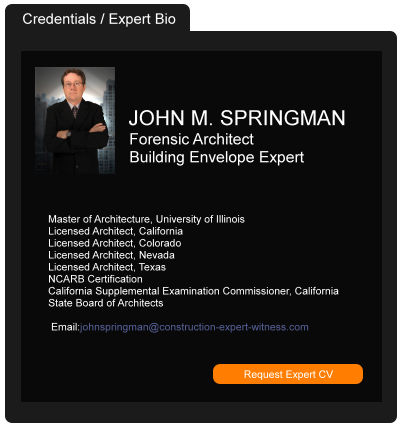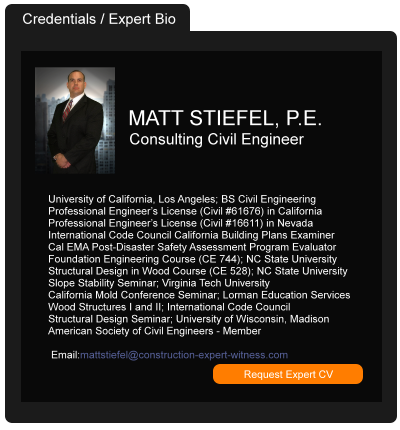An Insurance Policy Isn’t Ambiguous Just Because You Want It to Be
December 20, 2021 —
David Adelstein - Florida Construction Legal UpdatesWhen it comes to insurance contracts, there is a rule of law that states, “where interpretation is required by ambiguity in insurance contracts[,] the insured will be favored.” Pride Clean Restoration, Inc. v. Certain Underwriters at Lloyd’s of London, 46 Fla. L. Weekly D2584a (Fla. 3d DCA 2021) (citation and quotation omitted). Stated another way: ambiguities in insurance contracts will be interpreted in favor of the insured and against the insurer.
With this rule of law in mind, insureds oftentimes try to argue ambiguity even when there is not one. This was the situation in Pride Clean Construction. In this case, the property insurance policy contained a mold exclusion that stated the policy did NOT insure for “a. loss caused by mold, mildew, fungus, spores or other microorganism of any type, nature, or description including but not limited to any substance whose presence poses an actual or potential threat to human health; or b. the cost or expense of monitoring, testing, removal, encapsulation, abatement, treatment or handling of mold, mildew, fungus, spores or other microorganism as referred to in a) above.” Not only did the policy not insure for loss caused by mold, it went further to state it was NOT insuring for any mold testing or abatement.
Read the court decisionRead the full story...Reprinted courtesy of
David Adelstein, Kirwin Norris, P.A.Mr. Adelstein may be contacted at
dma@kirwinnorris.com
No Duty To Defend Additional Insured When Bodily Injury Not Caused by Insured
July 26, 2017 —
Tred R. Eyerly - Insurance Law HawaiiThe court found there was no duty to defend a suit for bodily injury against the additional insured where the injury was not caused by the insured. Consigli Constr. Co. v. Travelers Indem. Co., 2017 U.S. Dist. LEXIS 95339 (D. Mass. June 21, 2017).
Consigli was the general contractor for a renovation project at a high school. Among the subcontractors was American Environmental, Inc., who was responsible for demolishing concrete floors within the existing structures, and Costa Brothers, who did the masonry work. Wellington M. Ely was an employee of Costa Brothers and worked as a mason on the project.
Costa Brothers had a CGL policy with Travelers. As a subcontractor, Costa Brothers agreed to name Consigli as an additional insured on its policy.
Read the court decisionRead the full story...Reprinted courtesy of
Tred R. Eyerly - Insurance Law HawaiiMr. Eyerly may be contacted at
te@hawaiilawyer.com
Avoid Five Common Fraudulent Schemes Used in Construction
December 02, 2019 —
Ken Van Bree - Construction ExecutiveHere’s an attention-getting statistic: A typical case of fraud in the construction industry has a median loss of $227,000, according to the 2018 Report to the Nations issued by the Association of Certified Fraud Examiners (ACFE) on occupational or internal fraud. This report further showed that the construction industry’s median loss is approximately $119,000 higher than the average fraud losses across all industries.
Construction companies are most at risk for fraud related to corruption (such as bribes and kickbacks), billing related schemes, expense reimbursements, check tampering and equipment or material theft.
This brings up three important questions:
- What are the fraud schemes affecting your company?
- How can contractors keep their companies from experiencing these types of fraud?
- What is the profile of fraudster?
The threat of fraud can never be wholly removed; however, companies should take steps to identify likely fraud schemes they might face. Below are a number of schemes frequently used to defraud construction companies.
Reprinted courtesy of
Ken Van Bree, Construction Executive, a publication of Associated Builders and Contractors. All rights reserved.
Read the court decisionRead the full story...Reprinted courtesy of
So, You Have a Judgment Against a California Contractor or Subcontractor. What Next? How Can I Enforce Payment?
May 04, 2020 —
William L. Porter - Porter Law GroupThe Contractors’ State License Board (“CSLB”) represents the interests of the public in California construction matters. In the field of California construction, the CSLB is all powerful. The agency has the right to suspend the license of any contractor or subcontractor who does not pay on a construction related judgment against it. If you are successful in obtaining a court judgment against a contractor or a subcontractor in a construction-related case, you can utilize the services of the CSLB to suspend the contractors’ license of that contractor or subcontractor until the judgment has been paid. Once the license is suspended, the contractor or subcontractor has no legal right to work as a contractor or subcontractor and can even be arrested for doing so. Details on using the CSLB to suspend the license of a contractor or subcontractor who has a construction-related judgment against it can be accessed at this particular CSLB link:
CSLB – Judgment.
On receipt of notice of the construction-related judgment, the CSLB will either suspend the contractors’ license of any contractor or subcontractor who does not pay on the judgment or who does not appeal the judgment to the Court of Appeals or file bankruptcy within 90 days. There also exists an opportunity for the licensed debtor to file a bond with the CSLB. The bond will either have to be renewed annually or the judgment paid, whichever comes first.
Read the court decisionRead the full story...Reprinted courtesy of
William L. Porter, Porter Law GroupMr. Porter may be contacted at
bporter@porterlaw.com
Henderson Engineers Tests AI for Building Systems Design with Torch.AI
September 26, 2022 —
Aarni Heiskanen - AEC BusinessTorch.AI is testing a new artificial intelligence application with Henderson Engineers, a national building systems design firm, to unlock the creative and problem solving potential of the firm’s more than 1,000 employees.
Henderson Engineers is a building systems design and engineering firm that works on projects across the business, community, health, retail, and venue sectors. Their projects include many high-profile projects, such as SoFi Stadium, host site for the 2022 Super Bowl. They know how the industry relies on highly complex information contained in equally complex unstructured data: drawings, images, PDFs, handwriting, raw text.
Earlier this year, Henderson began testing new artificial intelligence from
Torch.AI that could learn to read complex construction and engineering documents and diagrams.
“When Kevin Lewis, Henderson’s CEO, and I got together to first discuss the partnership, I could tell they were already thinking way ahead of everyone else,” says Brian Weaver, Chairman and CEO of Torch.AI. “As an engineering firm they are meticulous, thoughtful, strategic. We quickly saw the potential impact these new AI systems could have for their amazingly talented teams and are excited to continue growing our relationship.”
Read the court decisionRead the full story...Reprinted courtesy of
Aarni Heiskanen, AEC BusinessMr. Heiskanen may be contacted at
aec-business@aepartners.fi
Insurance Telematics and Usage Based Insurance Products
October 29, 2014 —
Robert Ansehl – White and Williams LLPThe New York State Department of Financial Services (the "DFS") issued Insurance Circular Letter No. 4 on May 27, 2014 (the “Circular Letter”). The purpose of the Circular Letter was to alert stakeholders of the DFS’ interest in obtaining information about products that use embedded telematic devices, including usage-based insurance products (“UBI”) that provide benefits to insurers and policyholders.
As data capture and transmission technology become more advanced, and as user interfaces become increasingly sophisticated, many insurers are considering UBI and other programs that rely upon telematic devices to monitor the behavioral patterns, tendencies and habits of insureds. For example, when these devices are installed in an insured's vehicle, a telematic device can gather driving data, including miles driven, the time of day the driver used the vehicle, and his/her speed, acceleration and braking patterns. This data can be captured and transmitted on a real-time basis that allows insurers to make more effective underwriting determinations and to better align pricing with an insured’s driving tendencies and the resulting attendant risks. Other insurers have applied UBI to homeowner’s insurance where, for example, smoke and other alarms and monitoring devices can monitor and transmit details regarding the resident's risk-based activities (for example, whether and how often and how long the insured uses ovens and stoves on an attended and unattended basis). This data can be used to facilitate an insurer’s ability to correlate insurance coverage decisions with the insured’s actual behavior (as opposed to self-reported behavior) as measured by sophisticated home-based telematic devices. In addition, UBI and other programs provide the data on a real-time basis, as opposed to collecting information via traditional means, principally based upon post-claim reporting. Tempering increased UBI usage are countervailing privacy and data protection concerns and risks. Regulators, insurers and consumers have significant stakes in the availability, access and applications of this information.
Read the court decisionRead the full story...Reprinted courtesy of
Robert Ansehl, White and Williams LLPMr. Ansehl may be contacted at
ansehlr@whiteandwilliams.com
Wendel Rosen’s Construction Practice Group Receives First Tier Ranking
January 28, 2015 —
Garret Murai – California Construction Law BlogWe try to limit our narcissism here at Wendel Rosen but every once in a while we toot our own horn. Lawyers are, after all, a rather sad, competitive, yet insecure bunch (i.e., we eat this stuff up).
We’re proud to announce that Wendel Rosen’s Construction Practice Group has received a first tier ranking in U.S. News & World Reports’ Best Law Firms for 2015. This is the second year the Construction Practice Group has received a first tier ranking. Yay us!
Read the court decisionRead the full story...Reprinted courtesy of
Garret Murai, Wendel Rosen Black & Dean LLPMr. Murai may be contacted at
gmurai@wendel.com
MDL Panel Grants Consolidation for One Group of COVID-19 Claims
November 02, 2020 —
Tred R. Eyerly - Insurance Law HawaiiPreviously denying consolidation of all COVID-19 business interruption claims [post here], the Judicial Panel on Multidistrict Litigation allowed consolidation of one group of cases against Society Insurance Company while denying consolidation of four other groups of cases. In re Soc'y Ins. Co. COVID-19 Bus. Interruption Protection Ins. Litigation, 2020 U.S. Dist. LEXIS 183678 (J.P.M.L. Oct. 2, 2020).
Claims against Society encompassed 34 actions filed in Illinois, Indiana, Iowa, Minnesota, Wisconsin, and Tennessee. The court found that centralization of the Society actions would serve the convenience of the parties and witnesses and further the just and efficient conduct of the litigation. The actions shared common factual allegations that Society wrongfully denied policy holders' claims for business interruption coverage. Plaintiffs contended that Society preemptively decided to deny their claims.
Read the court decisionRead the full story...Reprinted courtesy of
Tred R. Eyerly, Damon Key Leong Kupchak HastertMr. Eyerly may be contacted at
te@hawaiilawyer.com


































































